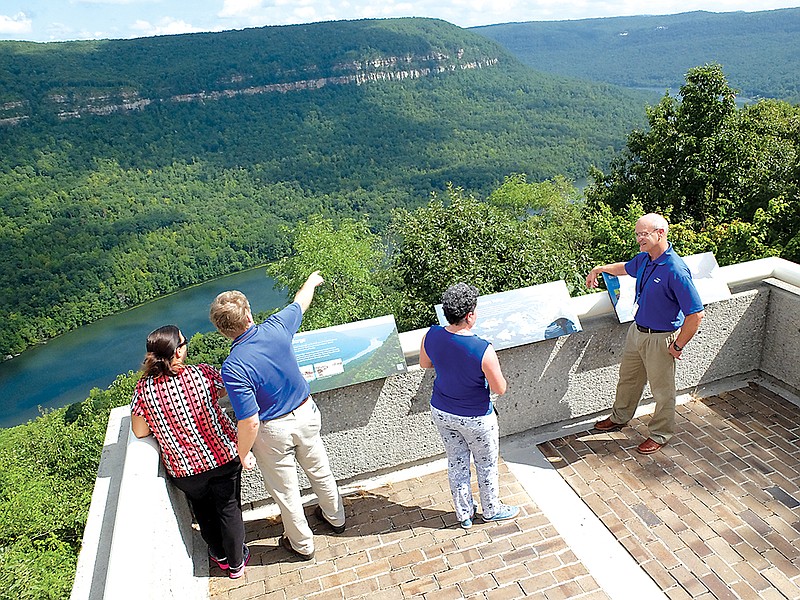Because of the decrease in fossil fuel plants, an old idea suddenly looks new again in the consideration of power generation for TVA.
The utility has begun to study whether a pumped storage power plant similar to the Raccoon Mountain facility just west of Chattanooga might be feasible for either of two mountain ridges along the Tennessee River in Northeast Alabama.
Such a plant would be located at either the closed Widows Creek coal unit near Stevenson, Alabama, or along Rorex Creek near Pisgah, Alabama. Construction cost estimates have been put at $2 billion to $4 billion.
Most of the pumped storage hydro capacity in the United States was built between 1960 and 1990. The Raccoon Mountain plant was begun in 1970 and was completed in 1978. The most recent such facility to come online was the San Diego County Water Authority's Lake Hodges project in California 2012.
Pumped storage plants are more than 100 years old, the first one having been built near Schaffhausen, Switzerland, in 1909. The first U.S. plant, according to the U.S. Department of Energy, was the Rocky River plant near New Milford, Connecticut, which opened in 1929 and is still operating today.
According to the federal energy department's 2021 Hydropower Market Report, there are 43 pumped storage plants operating in the U.S.
Since renewable energy projects like solar and wind generation are dependent on the sun shining and the wind blowing, pumped storage plants offer the capacity for energy when solar and wind are nonproductive. They work like a giant battery, drawing up water from lower sources to storage lakes atop a mountain during off-peak hours and then releasing it back down the mountain to lower sources to engage turbines and produce energy in peak-need hours.
The Tennessee Valley Authority has both solar and wind facilities but, prudently, has not overinvested in their generation because of cost, varied generation and the efficacy of other energy sources.
The utility also operates three nuclear plants, including Sequoyah above Chattanooga, but new solo nuclear reactor plants can take more than a decade to plan and build, cost double ($6 billion-$9 billion) what the estimates for a pumped storage facility are and require significant federal oversight.
That's not to say a pumped storage plant is cheap, would come in at budget, would be completed on time or would be without environmental concerns.
Raccoon Mountain was none of those.
Originally predicted to cost $155 million, its final cost was exactly double that, $310 million. Originally predicted to come on line in 1974 or 1975, it did not begin producing energy until 1978 and was not fully commercial until the 1980s. The final impact statement of a TVA environmental review of the project in 1976 said the greatest impact of construction was the "clearing and inundation of the mountaintop reservoir area" (10 million cubic yards of earth displaced). It said any future impact on "fish and other aquatic life from the pumping and generation cycle" was not expected to be significant.
However, Raccoon Mountain has a generating capacity of 1,652 megawatts. Comparably, either of the two units at the Sequoyah Nuclear Plant has a capacity of more than 1,160 megawatts, but together they can produce more than Raccoon Mountain. Chickamauga Dam, meanwhile, has a net dependable capacity of 119 megawatts, and TVA's Buffalo Mountain Wind Farm has a capacity of 27 megawatts.
A pumped storage power plant also has other advantages. Raccoon Mountain, for instance, features a 523-acre lake, 28 miles of trails for hikers or bikers, and opportunities for fishing, picnicking and wildlife viewing.
Jackson County, Alabama, Commission Chairman Bill Nance envisions a similar site with "opportunities open to our citizens such as hiking and biking trails, camping and picnic areas, habitat improvements and improved river access."
But studies for such a facility are just that. Discussions about other such units in the tri-state area since Raccoon Mountain opened have come and gone. TVA previously had considered another site in the Sequatchie Valley for a facility, and four years ago a private developer proposed building one on Sand Mountain near the intersection of Tennessee, Georgia and Alabama. Neither came to fruition.
And, as an alternative to a new plant, TVA also is studying the possibility of expanding the power output at Raccoon Mountain. The specifics of such a project are unclear.
That expansion proposal and the two sites for a new plant in Northeast Alabama are open for public comments (pumpedstorageNEPA@tva.gov) through July 5, and a virtual public meeting will be held on June 22 at 6 p.m.
We see pumped storage generation as much more fruitful than major expansions of solar and wind power systems and perhaps even critical if more renewables do come online in years to come.
Indeed, pumped storage is an idea whose time has come ... again.
